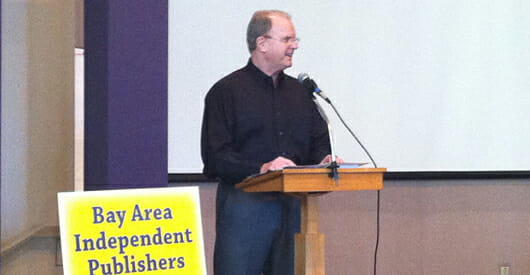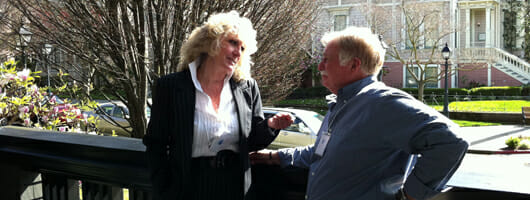The 2011 edition of the Bay Area Independent Publishers Association (BAIPA) all-day workshop, the Get Published! Institute, found a new home in downtown Oakland this year amidst the beautifully preserved Victorians of Preservation Park.
A good sized crowd of about 80 filled Niles Hall for a day full of talk on writing, publishing and selling books. These type of events are great for an immersion in the world of indie publishing, and people who come to learn from the experts here can go home with a huge amount of information, much of it practical and ready to implement.
The day was kicked off by a keynote from Jim Horan, author and proprietor of the One Page Business Plan empire. Jim, who got a big help in his beginning as a publisher from BAIPA made a point of handing out many copies of his books, and explained that this was a basic form of marketing.
Brian Jud on Special Sales
 Soon the main speaker for the day, Brian Jud, took the stage to give his presentation on special sales. Jud is probably the leading authority in indie publishing on special sales. This encompasses all sales made outside the book distribution system.
Soon the main speaker for the day, Brian Jud, took the stage to give his presentation on special sales. Jud is probably the leading authority in indie publishing on special sales. This encompasses all sales made outside the book distribution system.
Jud has been presenting this valuable material for some time, and has many sales he has either made or facilitated for clients that illustrate his points. Examples of sales to corporations, government agencies, the armed forces, sales to non-bookstore retailers and more helped show how he finds channels in which to sell books.
Jud also pointed out several times that terms are much more favorable in these sales than they are in normal book distribution. Typical arrangements for a special sale are 50% discount, cash with the order and no returns. Often these sales can be used by publishers to reduce the print cost of their own copies of a book by creating a longer print run.
Special sales also account for large orders from corporations or others for books to be used as premiums or incentives, and instances where the books can be branded with the customer’s identity to enhance the usefulness of the books in promotion.
Jud’s book, How to Make Real Money Selling Books is a thorough treatment of this subject that any self-publisher could profit from.
Subsidiary Rights Presentation
The other main presentation at the Institute was by Jon Tandler and Lloyd Rich, (shown below), publishing attorneys. Their talks was called “Subsidiary Rights—Maximizing Your Bottom Line,” and dealt with sales of rights outside the normal print book publishing agreement.
 They had a sophisticated set of slides (the only presenters to use them) covering many areas of subsidiary rights and how they should be managed, leveraged and monetized. Lloyd Rich, a publisher who left the world of books to “follow his bliss” as a lawyer, made the point that although publishers have sold subsidiary rights for many years, lately some of this activity occurs under the name “content monetization.”
They had a sophisticated set of slides (the only presenters to use them) covering many areas of subsidiary rights and how they should be managed, leveraged and monetized. Lloyd Rich, a publisher who left the world of books to “follow his bliss” as a lawyer, made the point that although publishers have sold subsidiary rights for many years, lately some of this activity occurs under the name “content monetization.”
They explained some of the complications of working with rights agents, who handle different rights licenses, intricacies of the publishing contract, which is basically a rights license, premiums, special sales, sponsorship publishing, co-publishing and other topics.
Although Tandler and Rich are obviously experts in their field with wide experience, it was difficult at times to see quite how their subject applied to the self-publishers who made up the vast majority of attendees. Much of it seemed aimed squarely at corporate publishers with staff, agents, and the accouterments of a much larger business than a sole self-publisher.
Breaking for Breakouts
After lunch there were two separate sessions of breakouts covering editing, book design, promotion, digital printing and children’s publishing. I sat in on two of the presentations, and really enjoyed Lin Lacombe‘s talk on publicity and promotion for self-publishers. Lin had lots of examples and encouraged authors to make publicity an integral part of their book marketing plan.
All of the handouts I saw were quite useful. Pete Masterson, president of BAIPA, had excellent handouts for his Book Design and Digital Publishing sessions, and Vicki Weiland, who did the session on Editing, gave out so much great information it was like a mini-course on book editing.
 After the breakout sessions, Brian Jud came back for his second session and made good use of his big pad of paper. He asked a volunteer with a book project to take part (Beth Barany) and used that project to show just how many different markets we could come up with to sell her book to. It was a terrific example of making the information he presented during the morning practical, as we could see exactly how he generates so many sales possibilities from one book.
After the breakout sessions, Brian Jud came back for his second session and made good use of his big pad of paper. He asked a volunteer with a book project to take part (Beth Barany) and used that project to show just how many different markets we could come up with to sell her book to. It was a terrific example of making the information he presented during the morning practical, as we could see exactly how he generates so many sales possibilities from one book.
There were a lot of show specials, and I ended up selling a good number of pre-release copies of A Self-Publisher’s Companion, the first time it’s been on sale.
I also met a number of blog readers, which is always fun.
Wrapping It Up for Another Year
Because the BAIPA institute two years ago marked something of a return for me to retail publishing, it make a convenient milestone for marking the time since, what has changed and what has not.
Although I enjoyed the institute and it was certainly valuable for attendees, it was also a bit of an anomoly.
For one thing, you might have noticed the similarity between the subjects presented by Brian Jud and the lawyers Tandler and Rich. In effect, they were very similar subjects dealing with sales of printed book outside bookstore channels.
 Thinking about it, that seemed like a pretty narrow focus for such a large-scale event. But as the day wore on, I had an even odder feeling.
Thinking about it, that seemed like a pretty narrow focus for such a large-scale event. But as the day wore on, I had an even odder feeling.
It was the feeling of being in a time warp. There we were, learning valuable lessons from Brian Jud, who has been teaching his valuable lessons for some time. We were trying to make sense of the subsidiary rights situation, something most self-publishers know nothing about. After all, they haven’t signed a contract with anyone, have they?
We had no internet access at the Institute, and we spent the entire day talking about print books. The whole thing could have easily taken place 15 years ago—or more—with little change.
Throughout the day, there were no sessions or mentions or even really that much talk about ebooks, ebook conversions, dealing with aggregators, publishing to Kindle, social media marketing, blogging, Facebook, Twitter, virtual blog tours, and I didn’t hear one person mention the word “Konrath.” There was almost nothing in the entire day relating to the forces that have most profoundly influenced publishing in the last 5 years, and which will shape the future of book publishing.
This is in stark contrast to last year’s main speaker, Dave Matheson, whose spirited call to action roused the indie passion of the attendees, or Kemble Scott’s tale of breaking barriers in e-publishing.
I’m not sure what to make of this, except that it left me with a surreal feeling. Amidst the restored Victorians of Preservation Park, it seemed that the conference was in a similar state of preservation. Perhaps next year it will break out of the past and embrace the onrush of events which we find ourselves confronting.
Or maybe it’s just my own prejudices showing up: the golden age of self-publishing that we’re experiencing is, to me, largely an online, networked and social media-connected phenomenon. The old days weren’t nearly as good as the new ones are turning out to be.


